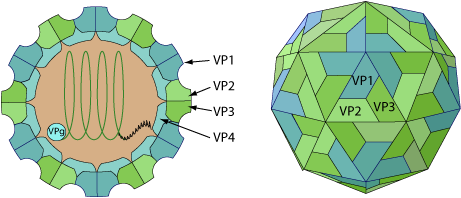Cardiovirus (taxid:12103)
VIRION

Non-enveloped, spherical, about 30 nm in diameter, pseudo T=3 icosahedral capsid surrounding the naked RNA genome. The capsid consists of a densely-packed icosahedral arrangement of 60 protomers, each consisting of 4 polypeptides, VP1, VP2, VP3 and VP4. VP4 is located on the internal side of the capsid.
GENOME
Monopartite, linear ssRNA(+) genome of 7.8 kb, polyadenylated, composed of a single ORF encoding a polyprotein. Viral genomic RNA has a viral protein (VPg) at its 5' end instead of a methylated nucleotide cap structure. The long UTR at the 5' end contains a type II internal ribosome entry site (IRES). The P1 region encodes the structural polypeptides. The P2 and P3 regions encode the nonstructural proteins associated with replication. Encodes a unique protease 3C. The leader (L) protein is thought to exert important functions in virus-host interactions. The shorter 3' UTR is important in (-)strand synthesis.
GENE EXPRESSION
The virion RNA is infectious and serves as both the genome and viral messenger RNA. The IRES allows direct translation of the polyprotein. The polyprotein is initially processed by the viral protease into various precursor and mature proteins to yield the structural proteins, replicase, VPg, and a number of proteins that modify the host cell, ultimately leading to cell lysis. Ribosomal skipping is used at the junction of the 2A and downstream sequence. A truncated version of the polyprotein is produced by ribosomal frameshifting in the 2B region of EMCV and ThV, producing only structural proteins and 2B*
 .
.
ThV is the only cardiovirus to produce two additional proteins from an ORF overlapping the L protein, in another frame. These two proteins, L*-18kDa and L*-15 kDa, are probably expressed through leaky scanning
 .
.
ENZYMES
- RNA-dependent RNA polymerase [RdRp]
- VPG-type capping [VPg]
- NTPase-helicase [2C]
- Polyprotein major protease (Peptidase C3) [3Cpro]
- Self cleaving protease (Peptidase C28) [L]
REPLICATION
CYTOPLASMIC
- Attachement of the virus to host receptors mediates endocytosis of the virus into the host cell.
- Upon endosomal acidification, the capsid releases VP4 that opens a pore in the host endosomal membrane and the viral genomic RNA penetrates into the host cell cytoplasm. Acidic PH dissociates the capsid into pentameric subunits.
- VPg is removed from the viral RNA, which is then translated into a processed polyprotein.
- Shutoff of cellular cap-dependent translation by activating 4E-BP1.
- Replication occurs in viral factories made of membrane vesicles derived from the ER. A dsRNA genome is synthesized from the genomic ssRNA(+).
- The dsRNA genome is transcribed/replicated thereby providing viral mRNAs/new ssRNA(+) genomes.
- New genomic RNA is believed to be packaged into preassembled procapsids.
- Cell lysis and virus release.
- Maturation of provirions by an unknown host protease.
Host-virus interaction
Apoptosis modulation
Picornaviruses modulate host apoptosis  .
.
Poliovirus infection activates the apoptotic pathway, involving mitochondrial damage, cytochrome c efflux, and consecutive activation of caspases (caspase-3 caspase and -9)  , whereas antiapoptotic activity has been attributed to cardiovirus leader protein
, whereas antiapoptotic activity has been attributed to cardiovirus leader protein  .
.
Modulation of apoptosis depends on the host cell-type and on the time the infection because of the presence of viral pro- and anti-apoptotic factors respectively at the beginning and at the end of the infectious cycle


 .
.
Autophagy modulation
Picornaviruses subvert the cell autophagic pathway to facilitates viral infection  :
:
- EMCV activates the autophagic pathway
Innate immune response inhibition
EMCV inhibits the host IFN-mediated response by cleaving RIG-I


ThV inhibits the host IFN-mediated response by inhibiting IRF-3


Host gene expression shutoff by virus
EMCV inhibits host translation by activating 4E-BP1  .
.
Cardioviruses inhibit host mRNA export

 . They seem to inhibit nuclear trafficking in general.
. They seem to inhibit nuclear trafficking in general.
Matching UniProtKB/Swiss-Prot entries
(all links/actions below point to uniprot.org website)14 entries grouped by protein
4 entries
Protein 2B*
9 entries
Genome polyprotein
1 entry
